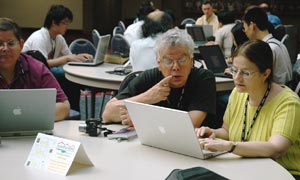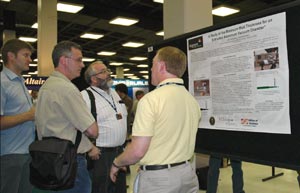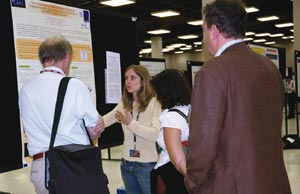Robert Garnett selects highlights from PAC ’07.
The 22nd Particle Accelerator Conference, PAC ’07, held in Albuquerque on 25–29 June was one of the largest yet. Nearly 1400 participants and 70 vendor companies attended, and more than 1400 papers were published, again demonstrating the important and prolific work that worldwide collaborations are doing in a multidisciplinary field. In all, it was a great success. This article briefly reports the highlights.

The high-energy frontier is still luring particle physicists and challenging accelerator designers and builders, with the next big step being the LHC at CERN. Following the accumulation of several minor delays, CERN dropped the plan for a low-energy run of the new collider later this year. The schedule foresees the commissioning of the machine at full energy starting in spring 2008. At the conference, talks and posters dealt with schemes for optimizing the performance of the LHC, as well as the potential for upgrades.

Meanwhile, US efforts at RHIC at the Brookhaven National Laboratory (BNL) now include luminosity improvements that will require the development of a facility at the cutting edge of beam cooling. Estimates suggest that electron cooling will require electron energies up to 54 MeV at an average current of 50–100 mA, and in a particularly bright electron beam. The aim is to generate this electron beam in a superconducting energy-recovery linac (ERL) using a superconducting RF gun with a laser–photocathode. An intensive R&D programme is currently underway. There are also plans for RHIC to produce 200 GeV polarized protons routinely, once there is a better understanding of the effects of polarization loss owing to intrinsic high-energy spin resonances. The acceleration of electrons at the proposed e-RHIC will allow continuity in the experimental programme, followed earlier at HERA, the electron–proton collider at DESY that shut down in July after 16 successful years of operation.

At Fermilab, the luminosity of the Tevatron proton–antiproton collider continues to improve, setting the record for hadron colliders. Fermilab has achieved the first electron cooling of a relativistic hadron beam (8 GeV antiprotons in the Recycler), contributing heavily to the success of Run II at the Tevatron. Studies of ways to improve further the beam–beam compensation efficiency in the Tevatron are also underway. Tests have already demonstrated compensation using electron lenses, paving the way for beam–beam compensation in RHIC and the LHC.
The conference also heard reports on the commissioning of multibatch slip-stacking in the Fermilab main injector. This technique has allowed doubling of the neutrino intensity for the Neutrino beam for the Main Injector (NUMI) project. Incorporating the Recycler for proton accumulation yields a four-fold increase in the neutrino source and may lead to a project dubbed SuperNUMI, although this could face strong competition from the Japan Proton Accelerator Research Complex (J-PARC) and an upgraded CERN Neutrinos to Gran Sasso (CNGS) project. Further steps will be necessary to ensure a leading position for the US in long-baseline neutrino experiments, such as Fermilab’s proposed Project X.

The high-energy frontier brings challenges that can only be met by strong, successful international collaborations. Barry Barish, director of the Global Design Effort for an International Linear Collider (ILC), reviewed the status, plans and main issues towards an ILC project. The Reference Design Report for the ILC, which will be based on superconducting (SC) RF technology, should be released in the coming months. The current baseline configuration uses the TESLA project’s SC cavity shape for the 500 GeV stage and assumes an accelerating gradient of 31.5 MV/m. The R&D programme includes work on alternative cavity shapes that promise higher gradients, but the designs are not yet mature enough to adopt as the baseline. The ILC will complement the LHC by allowing precision measurements at well-defined energy and angular momentum in the same regime, without the complications of the complex composite structure of the protons.

The push towards even higher energies requires innovative approaches. Visiting researchers from the University of California Los Angeles and the University of Southern California are working with researchers at SLAC to investigate plasma wakefield acceleration and have already demonstrated the energy-doubling of the 42 GeV electrons from the three-kilometre long SLAC linac in a plasma device less than a metre long. The implied acceleration gradient of 50 GeV/m is more than three orders of magnitude greater than in the SLAC linac. The same team had presented at PAC ’05 the results of a first demonstration of an energy gain greater than 1 GeV. It is remarkable that they extended their work in such a short time to test the concept of a plasma afterburner for doubling the energy of a beam from a real collider. This concept is expected soon to become a realistic technology for building future accelerators.
Lower energies, higher powers
At low to medium energies, the emphasis is often on achieving higher powers, either in sources or injectors for higher-energy machines or to deliver final beams at lower energies. The conference heard the latest results from commissioning studies at J-PARC and at the Spallation Neutron Source (SNS) at Oak Ridge. Both facilities are producing exciting results and are on track for ramping up to high beam powers. There were also reports on the successful first-stage commissioning of TRIUMF’s Isotope Separation and Acceleration (ISAC) facility, ISAC-II; the status of the Dual-Axis Radiographic Hydrodynamic Test phase II commissioning at the Los Alamos National Laboratory; and the results from commissioning of the proton linac for the Low Energy Neutron Source at Indiana University. Talks about non-scaling, fixed-field alternating gradient (FFAG) accelerators discussed new developments in this class of machine. There were also reports on the status of the Facility for Antiproton and Ion Research (FAIR) at GSI and on the results of longitudinal profile measurements made in the SNS linac.

Invited speakers on the latest source and injector technology looked at the development of reliable high-current, low-emittance injectors for various applications, particularly high-power spallation sources and heavy-ion fusion. Specific topics included GaAs-based photoguns with a high degree of polarization, and laser-driven sources of heavy ions with an emphasis on direct plasma injection into the subsequent accelerator structure. The general design principles for an electron cyclotron resonance (ECR) source of heavy ions were illustrated with a design for an advanced ECR. The meeting also discussed a multi-beamlet injector for a heavy-ion fusion accelerator, as well as the test and production versions of a high-performance electron-beam ion source for very highly charged heavy ions. In addition, contributed papers presented an optically pumped source of polarized H– ions with a very high degree of polarization; new development approaches with RF-driven H– ion sources; model-based optimization of plasma parameters for ECR ion sources; and a comparison of measured and simulated beam inhomogeneities found with ECR ion sources.
Applied accelerators
Accelerator-based facilities support a rich and diverse set of user programmes in basic and applied science, but at the same time there is an increasing number of varied applications for accelerators. The interest in hadron therapy continues to grow around the world as the number of new facilities in both design and construction stages demonstrates. Although cyclotrons and synchrotrons are the technologies of choice for these facilities, efforts to optimize cost and performance have reinvigorated interest in other technologies, such as FFAGs. New concepts for strengthening US national security involving accelerator technology and the production of particle and photon beams are also emerging, as scanning systems are tailored to address specific concerns. In addition, high-power, energy-recovered free-electron lasers (FELs) are enabling new applications for accelerators in research and industry.
The next generation of advanced light sources will provide many exciting research possibilities. Recent advances, such as ERLs, are making intense, broadly tunable sources of X-ray and XUV radiation feasible. These will allow real-time studies of reaction dynamics in chemical systems on the femtosecond timescale – previously thought impossible. The only short-wavelength FEL currently in operation is the FLASH facility at DESY. Important “pump probe” experiments are already underway there to test the theory. Future facilities may lead to quantum-level chemical control and reaction initiation at room temperatures, and may offer new insights into the dynamic behaviour of matter at the atomic level.
The success and continuing progress of three operating FELs based on ERLs (the Jefferson Lab IR FEL, the Japanese Atomic Energy Authority’s FEL and the high-power THz FEL at the Budker Institute for Nuclear Physics) promise many future applications in ERL technology. Besides high-power FELs and light sources, applications also include electron cooling and high-luminosity electron–ion colliders. The challenge will be in achieving high electron source brightness, maintaining high beam brightness during beam transport and acceleration/deceleration, and controlling high and peak current effects in superconducting RF systems. Some of these challenges are already being addressed within the projects now underway to build X-ray FELs at SLAC, Spring-8 and DESY. All three of these XFELs will rely on the principle of self-amplified spontaneous emission, which does not require mirrors and allows wide wavelength tunability. Talks and posters covered current progress at these facilities as well as new concepts based on computer modelling and theory.
As is now the trend, the largest number of contributions at the conference concerned beam dynamics and the accurate computation of electromagnetic fields. Implementation of 3D electromagnetic simulations for complex geometries and processes continues to advance in direct proportion to advances in computer hardware and storage capabilities. The direct link between these calculations and the ability to optimize the performance and operation of modern accelerators is clear. Scientists are developing sophisticated models to address many of the difficult technical issues facing the next generation of machines, such as beam losses and halo formation in high-intensity hadron beams, space-charge driven resonances, tailoring beam phase-space distributions, and understanding electron cloud effects. Talks and posters at the conference presented a broad range of topics, including collective effects and instabilities, developments in codes and simulations, single- and multi-particle dynamics, and beam optics. In particular, the conference heard of the latest simulation and experimental results of bunch compression in high-intensity electron bunches – important for both current and next-generation FEL projects.
Talks on instabilities and feedback emphasized new results in controlling collective effects through wideband feedback and in impedance or instability computation, benchmarked with instability observations. These included the successful demonstration of wideband feedback against electron–proton instability and for longitudinal stochastic cooling of a high-energy bunched beam. Two studies of the suppression of the electron cloud effect have led to in situ tests of TiN/Al-coated flat and grooved chambers and an idea for a distributed, low-impedance clearing electrode. Other contributors described analytical and/or experimental studies of novel instabilities in cooled antiproton beams, the possible interplay between resistive wall and fast beam-ion instability, and vertical instability in a proton bunch tail; they also discussed cures. Finally, impedance computation remains an important subject, in particular the accurate computation of the transverse impedance of LHC collimators verified with beam tests, reduction of taper impedance through nonlinear tapering, and the use of the impedance database computation method to predict accurately single bunch limits and collective effects.
The integration of sophisticated beam modelling and computer controls continues to advance. The conference heard about recent progress in developing software tools for commissioning the SNS, while posters and talks also discussed modern accelerator control architecture and its use in machine and personnel protection. A concluding overview of modern accelerator control systems emphasized the continuing need for global standardization and collaboration. Although construction of the ILC is not imminent, much thought has already been given to the control and operation of this machine of the future.
The next PAC conference will be in Vancouver in June 2009.








